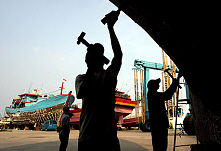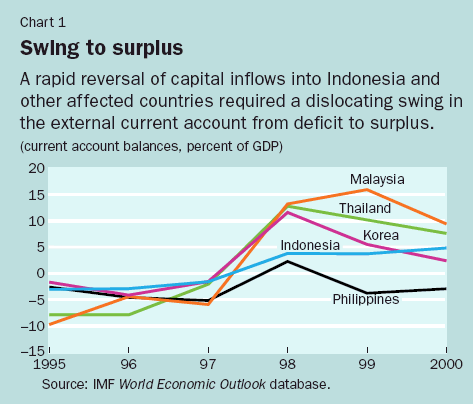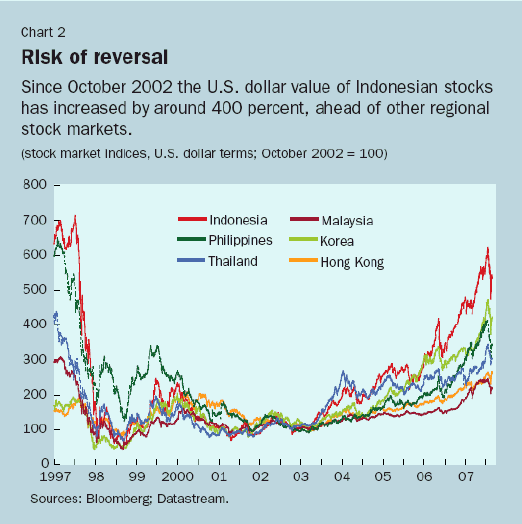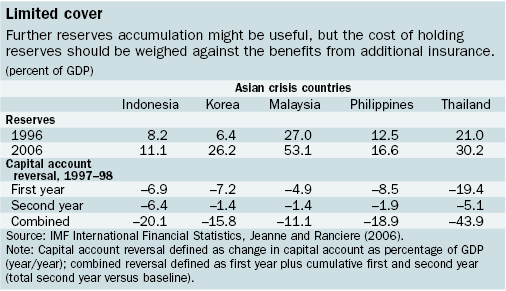
Typical street scene in Santa Ana, El Salvador. (Photo: iStock)
IMF Survey: Indonesia Better Set to Ride Out Storms
September 14, 2007
- Indonesia's vulnerability to another financial crisis has been reduced
- Recent upheavals in U.S. credit markets suggest renewed global volatility ahead
- Strong policies leave country reasonably well positioned to ride out any storm
Indonesia experienced substantial capital inflows up until May of this year, followed by outflows in the wake of the recent global market turmoil.

Dry dock in Jakarta, Indonesia: country's vulnerability to new financial crisis is much reduced after policy improvements (photo: Beawiharta/Reuters)
DECADE AFTER ASIAN CRISIS
For some, this reawakened memories of the 1997-98 Asian crisis, especially as Indonesia was the Asian emerging market economy most severely affected by the regional financial crisis ten years ago and took longest to recover. The severity of the crisis was all the more surprising because Indonesia's economy appeared (at least superficially) in better shape prior to the crisis than some of the other affected countries.
The crisis also triggered reforms that sought to tackle deep-rooted institutional problems. Taken together with recent sound macroeconomic policies and a more benign external environment, these reforms have helped to reduce the country's financial and macroeconomic vulnerability ten years on from the crisis.
Rapid reversal
The 1997-98 regional financial crisis had a devastating impact on Indonesia. In common with the other affected countries, a rapid reversal of capital inflows required a dislocating swing in the external current account from deficit to surplus (see Chart 1).

While the reversal in the current account was less severe in Indonesia than in some other countries, the associated recession was particularly deep. Output declined by 13 percent in 1998, while the currency had lost more than 80 percent of its value by June 1998. Unemployment, inflation and poverty soared.
The tenth anniversary of the crisis has prompted analysts and policymakers alike to ask whether Indonesia could witness another similar slump. Such concerns were heightened during the recent turmoil in global financial markets.
However, a repeat of the 1997-98 crisis seems unlikely, given Indonesia's successful program of financial sector reforms and its recent record of sound macroeconomic policies, and Indonesia's recent resilience in the face of market turmoil seems to support this view. Nevertheless, some vulnerabilities remain.
Short-term borrowing
While some earlier economic crises in emerging markets owed their origins to unwise macroeconomic policies or external macroeconomic shocks, the Asian crisis was driven primarily by weaknesses in the financial sector. This was particularly true for Indonesia, where fiscal policy was conservative and the external current account deficit relatively unthreatening before the crisis. However, excessive external short-term borrowing left Indonesian corporations and the domestic banking sector exposed to a sudden exit from the de facto exchange rate peg.
The crisis prompted reforms to financial sector regulation and supervision. Regulatory changes in the banking sector tightened rules across the board, including in the areas of loan classification and provisioning, related-party lending, capital adequacy and foreign exchange risk. In addition, the postcrisis restructuring of insolvent banks removed banks from related corporate groups, helping to solve the related-lending problem.
Macroeconomic policies have helped to further reduce vulnerabilities. Fiscal deficits are modest and public debt is declining, the external current account is in surplus, and the exchange rate is more flexible. A steady buildup of reserves and lower external borrowing have increased the ratio of reserves to short-term debt to more than 150 percent, around three times the precrisis level.
Improvements at the policy level have been reflected in a postcrisis recovery in financial and corporate sector indicators. In the banking sector, nonperforming-loan ratios have fallen significantly from their crisis peak and are comparable to those of other countries in the region, and capital-asset ratios have increased.
Diminished risks
The corporate sector is less leveraged, with debt-equity ratios on a declining trend. Partially, these developments reflect the low level of financial intermediation. Nevertheless, they point to substantially diminished balance-sheet risks compared with the precrisis period.
Overall, the reforms to macroeconomic and financial regulatory policies and improved financial indicators (many of which were not even available as indicators of vulnerability in 1997) suggest that a direct repeat of that crisis is unlikely. Nevertheless, Indonesia does remain vulnerable on several fronts, and policymakers are rightly focused on minimizing these risks.
First, in common with other countries, Indonesia faces increased risk of financial contagion as financial markets become more integrated and the volumes traded increase in relation to the real economy. The recent volatility in global financial markets, originating in the U.S. credit market but rapidly spreading across geographical borders and asset classes, is illustrative of this increased risk.
Contagion—as investors' concerns over Thai assets spread to wider worries about the financial sector in emerging Asia—helped to initiate the crisis in Indonesia in 1997. That said, the crisis was magnified, and investors' fears were validated, by domestic factors—notably the high levels of short-term external borrowing and excessive risk-taking in the financial sector, as discussed above.
Stronger balance sheets
With the financial and corporate sectors now enjoying stronger balance sheets, contagion risks should be easier to manage (as appears to have been the case during the recent global turmoil). Further progress in strengthening macroeconomic policies, notably in bringing inflation—and hence interest rates—down to the levels in other regional economies, will further diminish contagion risk by reducing the role of rupiah assets in carry trades.
Second, a rise in asset values, notwithstanding the recent falls, carries risk of a more serious reversal. Since October 2002 the U.S. dollar value of Indonesian stocks has increased by around 400 percent, ahead of other regional stock markets (see Chart 2). Much of this is a delayed catchup following the crisis, and economic fundamentals remain sound.

Nevertheless, with price/earnings ratios above those in many other countries in the region, and close to precrisis levels, the significant correction that occurred during the recent market turmoil was not entirely unexpected. Further sharp declines could trigger a wider economic impact via investor confidence, interest rates, and the exchange rate, although relatively strong balance sheets in the corporate and financial sectors would likely minimize second-round effects.
Exchange rate flexibility
Third, the buildup in reserve assets in the region has largely outstripped that in Indonesia, even though the latter's accumulation has itself been substantial. This has raised questions as to whether Indonesia has amassed a sufficiently large quantity of assets to ride out any subsequent capital account crisis.
Certainly, the current level of reserves—equivalent to around 11 percent of GDP—is still limited compared with the capital account reversal experienced in 1997-98 (see table). While this suggests some further reserves accumulation might be useful, the substantial cost of holding reserves needs to be weighed against the benefits from additional insurance.

Other policies, including continued exchange rate flexibility, ongoing vigilance with respect to external and domestic vulnerabilities, maintaining low and stable inflation, and strengthening financial safety nets, can help to reduce the probability of a crisis occurring—or attenuate its likely magnitude—at a lower cost to the taxpayer.
Indonesia's economy has come a long way in ten years, and its vulnerability to another debilitating financial crisis is much reduced. The recent upheavals in U.S. credit markets suggest a period of renewed global volatility ahead, and emerging markets in particular remain vulnerable to sharp reversals in investor sentiment. Nevertheless, Indonesia's recent record of strong policies and improved financial health leaves it reasonably well positioned to ride out any storm.


